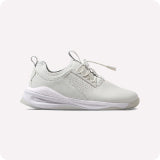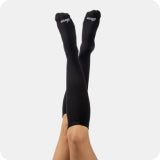Tips to Alleviate Swelling in Your Feet
Experiencing swelling in your feet can significantly impact your daily life, making simple tasks uncomfortable and challenging. This common issue often results from factors like prolonged standing or underlying health conditions, but it doesn't mean you have to suffer through the discomfort. Understanding what to do if your feet are swollen can improve your foot health and overall comfort throughout the day. By adopting effective remedies and making smart lifestyle adjustments, you can take proactive steps towards helping to alleviate this issue and enhancing your quality of life.
Causes of Swollen Feet
Swollen ankles and feet can result from a variety of causes, ranging from everyday activities to complex health conditions. Once you figure out how to check for swollen feet, here’s a deeper look into some common contributors:
Prolonged Standing
Standing for extended periods is a common cause for swollen feet, particularly in professions that require constant uptime. The gravity pulls blood down into the legs and feet, where it can accumulate and cause swelling. Wearing supportive footwear and taking regular breaks to sit or elevate the feet can help mitigate this issue.
Poor Circulation
Circulatory problems can lead to swollen legs and feet because they prevent the blood from flowing efficiently back up toward the heart. Conditions such as varicose veins or peripheral artery disease can impair blood flow, accumulating fluid in the lower extremities. Managing underlying conditions and using compression garments can assist in improving circulation.
Pregnancy
During pregnancy, the body produces more fluids and blood to support the developing fetus, which can lead to swelling in the feet and ankles, especially in the later stages. Swollen pregnancy feet are also exacerbated by the growing uterus putting pressure on the blood vessels in the pelvic area. Regular rest with elevated feet and proper hydration can help with this.
Long Flights
Sitting for long hours during flights can also lead to swollen feet and ankles. This condition, commonly referred to as "traveler's edema," occurs because of restricted movement, which can impede blood circulation. The cramped seating positions on flights force the legs to remain in a static posture, contributing to fluid accumulation in the lower limbs. To combat swollen feet after flying, it's recommended to periodically stand up, stretch, and walk around the cabin when possible. Wearing compression socks during flights can also help maintain blood flow and prevent swelling.
Home Remedies and Lifestyle Changes
To manage and reduce swelling in your feet effectively, several home remedies and lifestyle adjustments can be highly beneficial. Here are some practical approaches to how to help swelling feet:
#1 Elevation
Elevating your feet above the level of your heart is a simple yet effective way to reduce swelling. This position helps improve circulation and allows gravity to facilitate the drainage of excess fluid that may have accumulated in your feet and ankles. Try to elevate your feet for 20-30 minutes, several times a day, especially after long periods of standing or sitting.
#2 Hydration
Drinking plenty of water helps to flush out excess salt and fluid from the body that can contribute to swelling. Proper hydration is essential for maintaining the balance of fluids in your body. Aim for 8-10 glasses of water a day and consider reducing your intake of caffeine and alcohol, which can dehydrate you.
#3 Dietary Adjustments
Reducing salt intake is crucial as high sodium levels can cause the body to retain water, leading to swelling. Incorporate foods rich in magnesium and potassium, which help balance fluid levels in the body. Foods like bananas, spinach, avocados, and nuts are great choices.
#4 Exercise
Regular physical activity, especially activities that involve the legs, can help pump fluid back up from your legs to your heart. Activities like walking, cycling, swimming, or yoga can significantly improve circulation and reduce swelling. Aim for at least 30 minutes of moderate exercise most days of the week.
#5 Compression Garments
Wearing compression socks or stockings can provide continuous pressure on the tissues in the legs and feet, helping to prevent the accumulation of fluid and assist in its return to the circulatory system. These garments are especially useful during long periods of standing or sitting, such as during travel or work.
#6 Temperature Therapy
Alternating between warm and cold baths for the feet can help reduce swelling. The cold water helps reduce inflammation, while warm water can improve circulation. Be mindful not to use extreme temperatures, particularly if you have conditions like diabetes that impair sensation in your feet.
#7 Massage
Gently massaging the swollen area can help stimulate the lymphatic system and improve circulation, which can reduce swelling. Use a gentle, pushing motion moving from the toes up toward the knees to encourage fluid drainage.
Compression Therapy
Compression therapy is an effective and non-invasive method for managing swollen feet and improving circulation. Compression socks or stockings work by applying gentle pressure to the legs and ankles, promoting blood flow and preventing blood from pooling in the lower extremities, which can lead to swelling. This increased circulation helps to reduce swelling, alleviate leg and foot pain, and prevent the progression of more serious conditions such as deep vein thrombosis.
When choosing compression socks, it is important to select the correct size and compression level. Socks are available in various levels, measured in millimeters of mercury (mmHg), indicating the amount of pressure they provide. For mild swelling and discomfort, socks ranging from 15 to 20 mmHg are usually sufficient. It's also important to consult with a healthcare professional to ensure you select the appropriate level of compression for your needs.
In terms of wearing compression socks, they should be put on first thing in the morning before swelling occurs and worn throughout the day for maximum effectiveness. Ensure they fit snugly but not too tightly, as they should compress evenly without cutting off circulation. Graduated compression socks, which are tighter at the ankle and gradually decrease in compression towards the knee, are often recommended as they help facilitate upward blood flow.
Clove's Solutions for Swollen Feet
Clove understands the unique challenges faced by those who spend long hours on their feet, be it for work, play, or life in general. With a commitment to comfort and functionality, we developed a range of footwear solutions and compression accessories designed to combat the issues associated with foot swelling and discomfort.
Our men’s sneakers and women’s sneakers are engineered with the needs of those constantly on their feet in mind, offering ample support and a comfortable fit. These sneakers are ideal for those who experience swollen feet, as they are designed to provide the stability and cushioning needed during long shifts. The footwear features lightweight construction and is made from breathable materials that help regulate temperature and moisture, further reducing the potential for swelling.
Together, our sneakers and compression socks offer a way to help manage swollen feet. By combining advanced footwear technology with targeted compression therapy, Clove helps you maintain your comfort and mobility, enabling you to live, play, and work at your best.
Sources:
- Harvard Health Publishing. What's causing swollen feet and ankles? https://www.health.harvard.edu/diseases-and-conditions/whats-causing-those-swollen-feet
- Healthline. 10 Home Remedies for Swollen Feet. https://www.healthline.com/health/home-remedies-for-swollen-feet
- Mimi Lee M.D. PA. How Does Compression Therapy Work? https://drmimilee.com/how-does-compression-therapy-work/
- Oklahoma Heart Institute. What You Need to Know About Compression Socks Before You Buy. https://oklahomaheart.com/blog/what-you-need-know-about-compression-socks-you-buy



